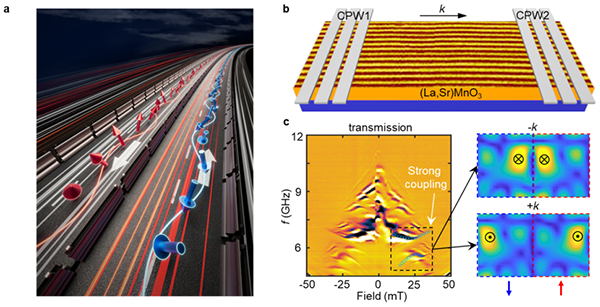Supported by the National Natural Science Foundation of China (Grant Nos. 52225205), Professor Jinxing Zhang’s group in Beijing Normal University and collaborators have made progress in the efficient propagation of a chiral magnonic edge state in a strongly correlated oxide. The research was published in Nature Materials on January 3, 2025, with the title “Switchable long-distance propagation of chiral magnonic edge state”. (Article link: http://www.nature.com/articles/s41563-024-02065-x).
The coherent spin waves, magnons, can propagate without accompanying charge transports and Joule heat dissipation, which are expected to be an alternative candidate for construction of beyond-CMOS logic circuits and exploration of emergent quantum states. Over the past 90 years, spin-wave-related physics have been widely studied in materials including ferro-, ferri-, and antiferro-magnets. In particular, the chiral magnonic edge states have been theoretically proposed and are predicted to be realizable in nanoscale spin textures, where backscattering of spin-wave propagation could be significantly reduced. Therefore, great efforts have been devoted to pursuing the room-temperature and long-distance propagation of spin waves in low-dimensional systems, which is, however, hard to be experimentally achieved. The major challenge is the lack of materials with the coexistence of low damping and ideal spin-wave nanochannels at room temperature.
Recently, research team led by scientists from Beijing Normal University artificially engineer magnetic damping (~3×10-4) and spin spirals (milimeter longth) of a strongly correlated oxide, La0.67Sr0.33MnO3, by designing its electronic bands and spin structures simultaneously, which builds up a robust “freeway” of magnonic edge state as schematically depicted in Fig. 1a. The antiferromagnetically coupled spin spirals (Fig. 1b) provide a strong dynamic dipolar interaction, which drive the strong coupling between optical magnons and domain-wall magnons (left panel in Fig. 1c). The micromagnetic simulation indicates that such a hybridized spin wave highly localizes and chirally propagates along the edge of nanochannel over long distance, i.e., chiral magnonic edge state (right panel in Fig. 1c). The observed hybridized magnons with a robust chirality can be reversibly and selectively switched on/off under external field, indicating a great potential for the design of versatile magnonic and spintronic devices at nanoscale.
This work proposed and independently completed by Chinese scientists not only provides a potential candidate for the design of beyond-CMOS devices with ultra-low power consumption, but also provides a new low-dimensional magnetic materials system for exploring and manipulating novel states such as magnons.

Figure a. An ideal magnon “freeway”. b. Chiral propagation of magnonic edge state in correlated-electron oxide with low magnetic damping and long spin spirals at room temperature. c. Strong magnon-magnon coupling and the chiral magnonic edge state.

Add: 83 Shuangqing Rd., Haidian District, Beijing, China
Postcode: 100085
Tel: 86-10-62327001
Fax: 86-10-62327004
E-mail: bic@donnasnhdiary.org
京ICP备05002826号 文保网安备1101080035号 Copyright 2017 NSFC, All Right Reserved